I’m not going to do little mini restaurant reviews of everywhere I ate, though I will mention where I ate things – I thought it might be more interesting overall to just look at the kind of things I ate while in La Paz. Most of it was traditional, but some was a bit more modern or creative. Most of it was quite good, though, not everything. This is going to be one long post….
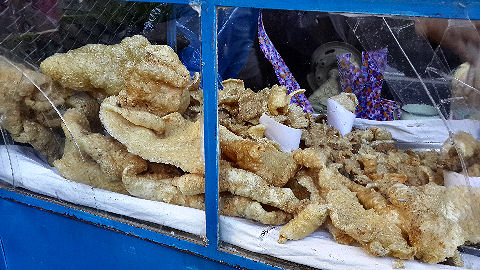
Let’s start with a little street snack –
chicharrones – pork cracklings – you see them available all over the place and for 2-5 bolivianos, basically half a dollar, you get anywhere from a small paper cone filled with them to a decent sized bag. Tasty, salty, surprisingly not greasy – just something to munch on while you walk around.
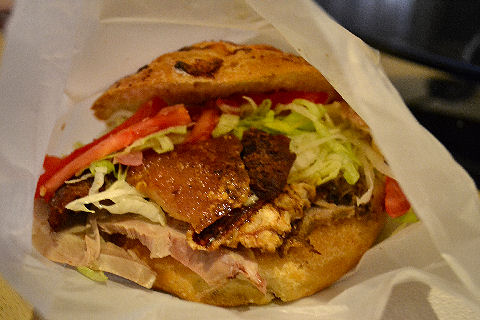
But maybe your tastes run to a different style of “porky goodness” as Bourdain would put it. There are plenty of carts where someone has a roast suckling pig or a haunch of a larger one, and they’ll carve off some slices, add some crispy skin, lettuce, tomato and your choice of sauces, all on a small sandwich bun.
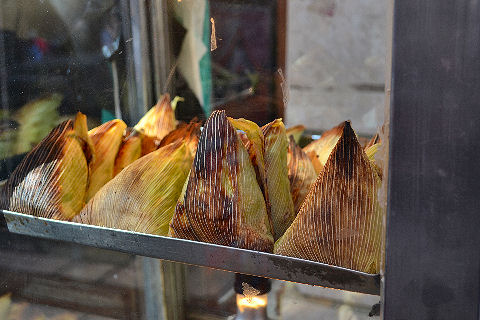
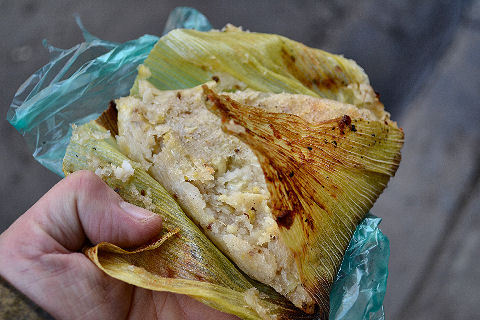 Humintas
Humintas are different in Bolivia than
humitas in Argentina, more than the “n” might imply. In the latter, they’re essentially a short steamed tamale made with fresh corn, cheese, and often a little green onion and/or pureed squash to bind it, and they’re usually a little sweet. In Bolivia they’re a mash or white corn and fresh cheese, wrapped into a triangle shape and then grilled or roasted in an open fire – they have a great smoky note, and, of course, they’re served up with hot sauce.
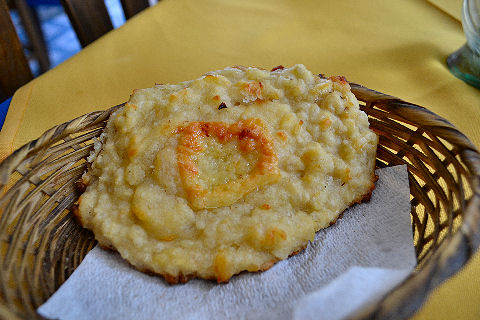
Stopped in at a little place up near the Jaen street museums called Gustito Oriental, as he had a display of different snack type items. I got to talking to him and he brought me a trio of things I hadn’t yet tried, along with a traditional local version of chicha (below in this post). This is a
pan de arróz (rice bread) – made with mashed yuca, rice flour, lard, cheese, salt, and a touch of sugar. Delicious! I could just sit around and eat these until I was fat and happy.
[Closed]
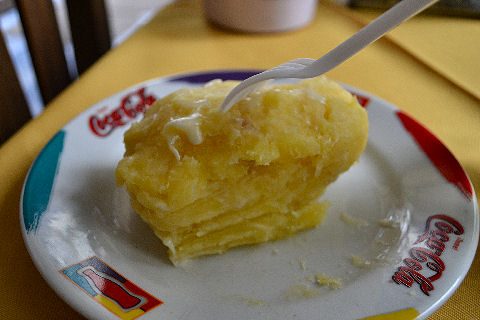
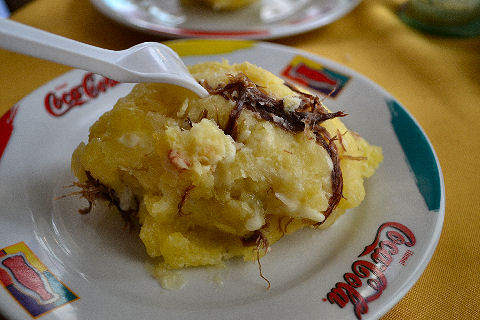
Two different dishes, but pretty similar – a
zonzo is mashed yuca and cheese with a little lard and flour to bind it together, and then it’s either oven baked or grilled – the form changes, sometimes potato shaped like this, sometimes flatter and in a small baking dish. The second photo is a
masajo, which basically substitutes shredded
charqui (cured, dried beef – similar in some ways to our “beef jerky”, and that’s actually where we get the word from) for the cheese.
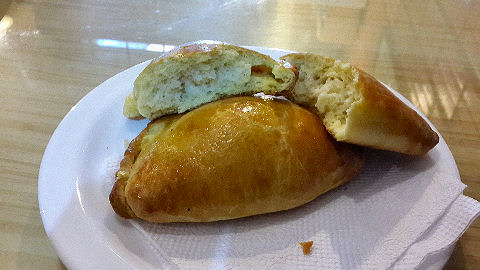
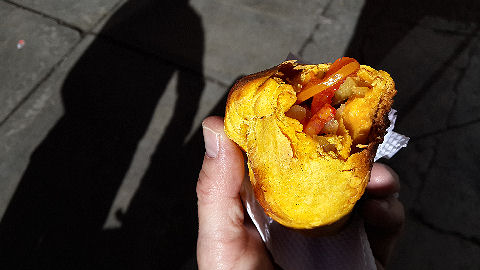
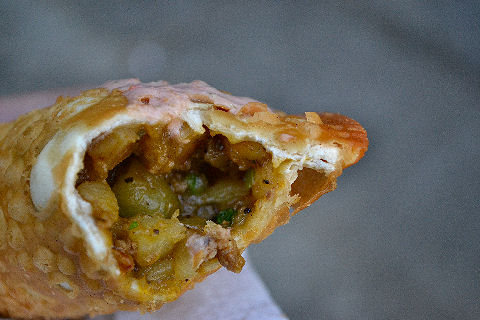
Okay –
empanada, salteña, and tucumana – the trinity of turnovers in Bolivia. Empanadas in Bolivia are not empanadas as we know them here in Argentina – they kind of look like them, but they’re basically bread all the way through with a thin filling of fresh cheese in the middle. They tend to be eaten later in the day with, say, an afternoon tea or coffee. A salteña is more similar to what we think of as a baked empanada – it’s packed with potato, and then either beef, chicken, both, or just vegetables. It’s eaten for breakfast, and people grab them on the streets – most stands are sold out by 10 a.m. for the day. Served with a range of hot sauces or, my favorite, slices of rocoto chili pickled in vinegar and sugar. There is a version called a salteña fricasé which is filled with stew and is quite messy to eat – more of a sit-down thing, with a spoon. And, the tucumana, much the same filling as a standard salteña, but it’s flatter and it’s fried and usually has bell pepper in it too. Served with a little salad on the side of red onion and cilantro, and topped with either hot sauce or cilanto sauce, though I also saw people putting ketchup and/or mustard on them. Everyone I asked about where to get the best tucumanas kept referring to “the Prado lady”- it took me some doing, but wandering along the Prado boulevard near to the obelisk I came across a trio of women with a bag full of tucumanas that they were happily eating – so I asked – and one of them actually got up and walked me the half block to a little teeny stand down from obelisk, stuck in a doorway (middle of the 900 block), where I also happily munched on a couple of these gems.
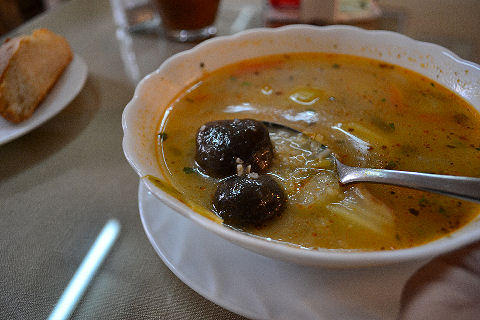
There are so many soups on offer, though all are a variation on theme – most of them include either
tunta or chuño (respectively the white and black versions of fermented, dried potatoes), or quinua as a starchy base, and from there the variation is what kind of meat, what kind of vegetables – but somehow, they all seem to taste pretty similar. This is
jakonta that I tried at a little place called Cafe Chuquiago up near the Plaza Murillo – it contains, if my notes are to be relied upon, beef broth, carrot, green beans, cabbage, several different herbs, rice, butter beans, potato, chuño, and a few pieces of beef. On its own, filling as hell, as part of a “lunch menu” of three courses, impossible to eat and then expect to follow up with two more plates.
[Closed]
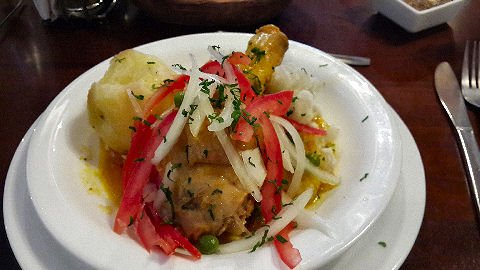
But hey, if you like your dried fermented potatoes, maybe go for a
sajta de pollo, as I did one day at La Casona – basically stewed chicken atop a bed of tunta (the white dried and fermented potatoes) that have been chopped up and steamed with cheese, though that’s not starchy enough, you have to have a boiled potato or two in the bowl as well, you know?
[Closed, replaced by new restaurant in the hotel]
A note about hot sauces – there seem to be three sort of standard types – there’s an ajicito, which is essentially a puree of chilies, often flavored with cilantro and maybe some vinegar – pretty much what we think of as a hot sauce here in a Peruvian or Bolivian restaurant; there’s llawa, which I’ve talked about way in the past – the classic recipes that I found were a base of pureed tomato, rocoto chilies and the herb huacatay (Amazon black mint) – sometimes with onion and/or garlic, and/or the addition of another chili. Most of what I found in La Paz though was almost pure tomato with just hints of the rocoto and huacatay, i.e., not very spicy. And, the third, is the salsa maní, or peanut sauce – kind of like a milder version of a Thai satay sauce (as you’ll see down below), without the ginger and some of the other spices.
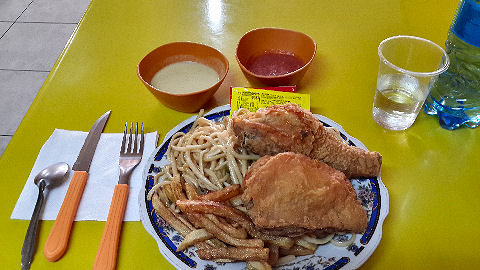
One of my chef friends here told me that in the couple of days he spent in La Paz all there was to eat was fried chicken – everywhere. I don’t know what neighborhood he was in, but while there was certainly fried chicken around, it was not ubiquitous. And, one has to be clear, there are three different kinds of fried chicken available here. This is
pollo broaster – the chicken is marinated in either vinegar or lemon juice and then dipped in a mix of flour, salt, mustard and chili powder, and then fried, and served over either rice or spaghetti, with french fries. That’s different from the broaster here, which is usually what we think of as rotisserie chicken – in Bolivia that’s called
pollo al spiedo (chicken on a spit) or
pollo rotisserie, served with salad and french fries.
Pollo frito is more of what we think of as fried chicken – it’s battered and fried and then served with a mound of french fries, and, of course, usually rice. And then there’s
Chicharrón de pollo, which is basically the same as pollo frito, but cut in smaller pieces, often boneless, and it’s served, as it is here in Peruvian restaurants, with salad and fries.
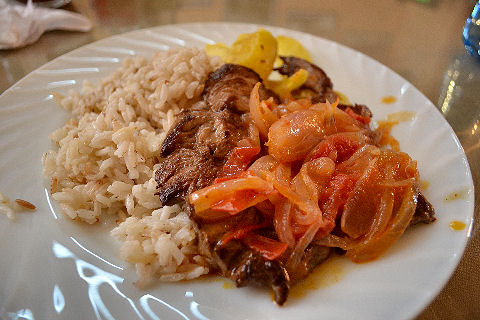
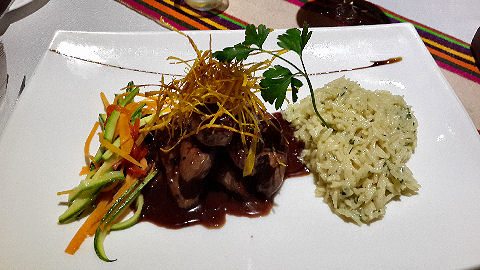
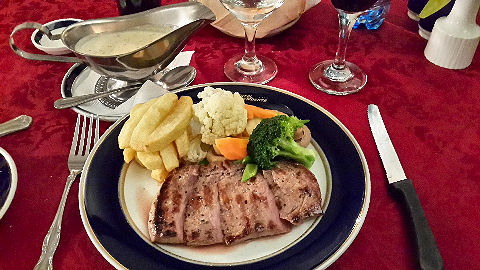
Llama meat is common in the area – it’s a very lean meat, and quite tasty. The most traditional way it’s served in La Paz is either stewed or, “
a la chorrellana“, as in the first photo – topped with a salsa of tomato and onion, and accompanied by rice and fried yuca. This, by the way, is the plate I was served after that massive bowl of soup above – couldn’t finish either of them. Llama is also the darling of the creative chefs around town – it’s something to show off with. The second photo is a plate of llama filet with a wild blackberry sauce – excellent dish at the restaurant Tomba Colonial in the Hotel Rosario, where I stayed – the rice on the side wasn’t quite the “risotto” promised, being just boiled rice with cheese melted over it, but it was good.
[Closed] The third photo is from the restaurant La Bella Vista – the place atop the Presidente Hotel where I took those great photos the first day – here, the waiter recommended against the stewed llama, saying that “it’s always really tough and chewy”, which just means either they don’t stew it long enough or they’re using the wrong cut of meat for stewing. He highly recommended the
churrasco of llama – basically grilled – and asked me if I wanted it medium or well done. I asked for medium rare, he said that wasn’t possible, no one would eat it that way. I asked for it that way anyway, and he went to ask the chef. Shortly, my plate arrived, a lovely rare to medium rare, and he told me that in several years of working at the restaurant it was the first time he’d ever seen the chef’s face light up with a smile when an order came in.
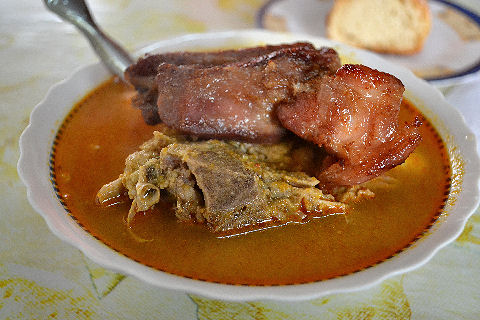
This is Bolivian
fricasé, quite different from what we think of as a
fricassee – it’s a quite spicy stew of
mote (those giant white corn kernels), both
tunta and chuño (the two main types of dried potatoes) and then beef that’s been stewed in it, and topped with a small slab of deep-fried pork belly (if you order the
fricasé mixto, otherwise you just get beef). Breakfast of champions!
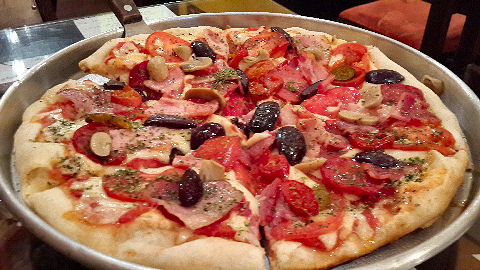
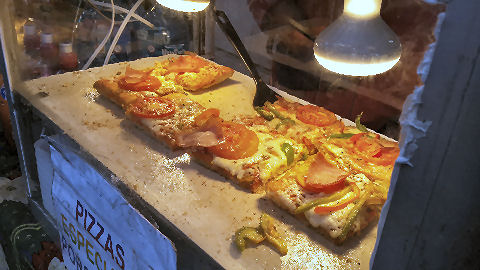
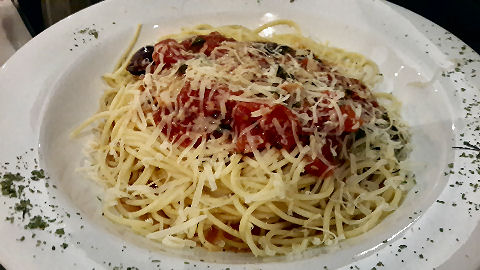
Italian food is big in La Paz as well, and you know me, I’ll try pizza anywhere. The first photo is from Mozzarella pizzeria, just down the block from my hotel. It may just be the best pizza I’ve had in South America – each pizza is a piece of art – and takes at least 30 minutes to get to you, the woman who runs the place takes great care in making each one and then double cooks them in a wood-fired oven – first just the dough with a hint of sauce so that the top gets lightly browned and doesn’t get soggy when the toppings are added – very smart, and I think I’m going to start doing the same! It was so good I went back another day for another pizza. This one is a mix of bacon, pepperoni, mushrooms, tomatoes, jalapeños, and olives. Pizza is also a very common street snack food, generally cut in little squares each one topped with a slice of tomato, bell pepper, and either ham or bacon. Like the other street food it’s offered with condiments, and I hesitate to even consider how many folk I saw topping their slices with mayo, ketchup or mustard. Finally, the pasta – I only mention it because it was, well, awful. There’s a popular cafe in the center area called Banheis that seems to always have a line of people waiting – this was overcooked, limp spaghetti, and the “putanesca” sauce was nothing but acidic canned tomatoes with some chopped olives and un-rinsed vinegary capers in it. No garlic, no chili, no anchovy. I shudder.
[Closed]
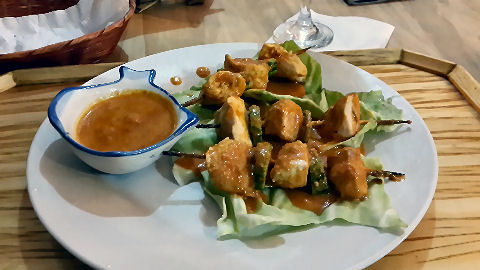
One night I just had to go out for something different. There are quite a few Asian restaurants around, and they all seem to be a mix of Thai, Japanese and Indian food – the menus are extensive, and at this place, Try Thai, every dish has a photo – of course, the actual plate you receive bears no resemblance to the photo. The chicken satay wasn’t bad – the sauce wasn’t satay sauce, but since as mentioned above, Bolivians have their own spicy peanut sauce, it was still quite good. The tempura udon was just nonsense – a bland broth of I don’t know what with undercooked to the point of chalkiness spaghetti in it (though the picture showed udon noodles, they didn’t even know what those were), and I have no idea what the batter on the tempura of shrimp, zucchini and onion was, but it was pasty and inedible.
[Closed]
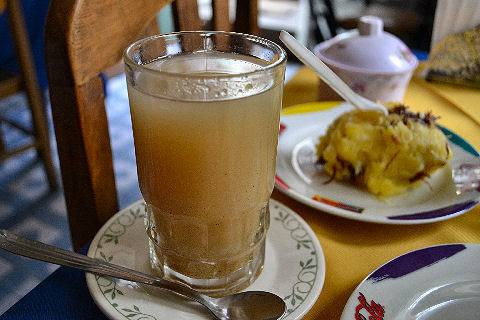
I mentioned above that along with my trio of yuca based treats I had a glass of
chicha camba – essentially the non-alcohol version of the Peruvian chicha de jora – a boiled white corn drink, just not fermented. Also, unlike our favorite chicha morada, it’s not sweetened nor infused with fruit, so it’s served with a bowl of sugar to sweeten to your own tastes – I left it unsweetened, it was kind of like a corn flavored iced tea.
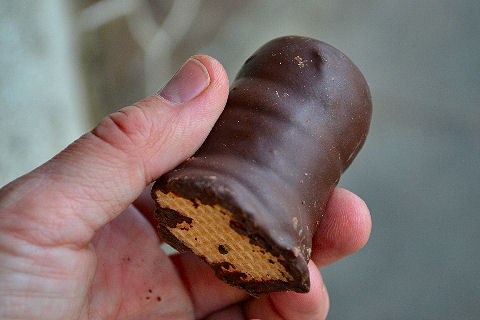
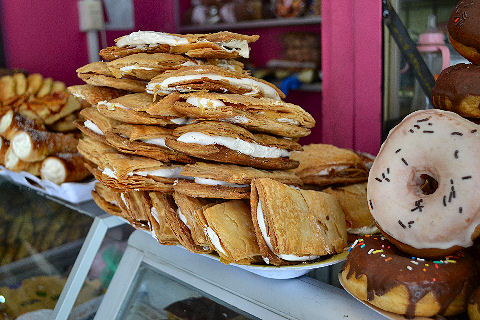
I’m not much of a dessert person, and most of the food I was eating was so heavy anyway, that I just wasn’t ordering things. Still, the occasional treat. Why the first of these is called a
condor, I don’t know. It’s a chocolate shell filled with fruit infused whipped cream (mango, strawberry or passionfruit seemed most common), and then capped on the bottom with a waffle cookie. The second is a
pastel de hoja, or leaf pastry – essentially two layers of puff pastry with vanilla whipped cream in the middle. Both seen everywhere.
Whew. Enough already, right? Next up a round-up of thoughts and street scenes, and then, we’re back to our regularly scheduled programming.





























[…] – what the Peruvians call one thing, the Bolivians call another (I did a little writeup on it here, towards the bottom.) So, the dish I’ve been diligently working on behind the scenes, is a […]
[…] On their cafe menu they listed salteñas and cheese empanadas, I talked about those a little in my writeup a few years back from La Paz. But it turned out to be irrelevant, as they didn’t have either […]
[…] to our sonsos…. Now, this one I’m not as familiar with. I’ve only tried a sonso, or zonzo, once, in La Paz. And that was a baked version, more like a side dish – in some ways reminding me […]
[…] Bolivians (or at least those from La Paz) love fried chicken, and I discussed the basics of the three styles of Bolivian fried chicken back when I was visiting La Paz, this is definitely the “pollo frito” […]